The Creation of the Kingston Bagpuize with Southmoor War Memorial Crescent
by Rob Belk, May 2013

Memorials Matter. They are the stepping stones of history. They make indelible the footsteps in the sands of time of ordinary people who became extraordinary - for us. We need to know about them. We need to remember. And honour. And thank. And take example. For throughout history, for civilisations to survive and flourish, some have had to be prepared to die. These selfless ones perhaps hoped that their sacrifice would be remembered and not have to be repeated. Our compact with the Selfless is Remembrance of them and what they gave for our Freedoms.
In December 2010, I was contacted by Jan Kelly, then Chair of the History Society and asked to prepare material for a History Society weekend entitled 'Our Villages in Wartime', scheduled for April, 2011. The scope envisaged included the villages covered by the History Society, being Hinton Waldrist, Longworth and Kingston Bagpuize with Southmoor. So began intensive research that culminated in the 'Our Villages War Dead' script and timeline. Like the Bayeux Tapestry, the War Dead Timeline told of war and the lives and deaths of 65 villager people in the great canvass of chaos that was their lives and their lot from 1914 to 1945.

'Our 65' included
- 48 in WWI
- 17 in WWII
- 2 women
- 11 brother multiples
- 3 second cousins
- 4 WWII dead of WWI dead parents or brothers
- 4 who emigrated and died under a foreign flag
In researching the war dead for Kingston Bagpuize, it quickly became apparent that the village had no proper external war memorial and that the two brass plaques in St John's church were incomplete (they didn't include two war dead buried in their own churchyard) and, in one case, inaccurate.
The 'Our Villages in War Time' presentation in Southmoor Village Hall in April 2011 also included anecdotal accounts of airplane crashes on and around our villages, from the standpoint of village witnesses. Some of the accounts were laced with conjecture as to the missions and causes of the crashes, with no record of the crews who were killed or facts surrounding the crashes.
So began the undersigned's campaign for (a) a proper external war memorial in Kingston Bagpuize and (b) to know more about the crashes and the crews who had died over and around our three villages.
The campaign for a proper and inclusive external war memorial in Kingston Bagpuize with Southmoor dovetailed with and gave real substance to another request to the Parish Council for some kind of external marker or memorial utilising stones from Southmoor Henge for the Afghan war dead, none of whom were from Kingston Bagpuize. In particular, John Weston was among that concerned band of people who, come rain or shine, stood out on the A420 to honour corteges of repatriated war dead from Brize Norton to John Radcliffe hospital, Oxford.
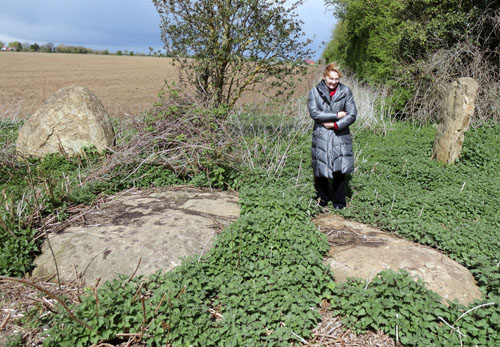
The stones at Southmoor Henge - Clare Belk indicates the size of the stones
Following representations to the Church Wardens, in July 2011 a proposal was tabled to the Parish Council for a proper external War Memorial that righted wrongs and properly recorded all of our local war dead, Allied Air Crews, forces based in the village that deployed to Normandy - and also honours those who have continued to sacrifice since WWII. Thus all the strands of Remembrance brought to bear in one external War Memorial.
There then ensued a number of Parish Council meetings to review the matter - at which, due to other commitments, I was unable to be physically present. In September, 2011, my proposal was tabled by John Melling and it was agreed to hold a round table meeting of interested villagers to further discuss. In November, 2011, there was a lot of interest when the 'Our Villages War Dead' banners were displayed in the churches in Hinton Waldrist, Longworth and Kingston Bagpuize. In December, 2011, my proposal was again discussed at the Parish Council and it was clear that funding would be required from the public.
In January, 2012, Ron Green launched the drive for funding by organising a Table Top Sale in Southmoor Village Hall that raised £250.
In March, 2012, my proposal for four stones and four acts of remembrance via plaques to be inset into the stones was debated and in April, the first of five requests for quotations went out for Stone Masons to quote for the plaques in either York Stone or Welsh Slate - with the objective of having all in place in time for the November, 2012 Remembrance Service. Brian Forster talked to Cliff Belcher who offered to move the stones for free.
By the end of June, 2012, my research on the Allied Air Crews who were killed in crashes on Kingston Bagpuize with Southmoor, Longworth and Hinton Waldrist was complete. I decided to hold-back the information on the Longworth and Hinton Waldrist crashes in order to concentrate on the key issue of 'righting the wrong' of no external War Memorial in Kingston Bagpuize.
July 2012 was a busy month in the creation of our Memorial Crescent
- there was much liaison with OCC Highways concerning the exact location of services (water, gas, electricity, sewage and telephone) beneath the chosen spot for the new Memorial at the junction of Oxford Road with Farringdon Road. We were sent maps - all of which contained concerning disclaimers as to accuracy
- we set our sights on a memorial made of five stones (not four - an even number was said to be unlucky - and a reason dignitaries are honoured with 21 gun salutes). We cleared more vegetation from the Southmoor Henge site and dug under and around the stones to try as best we could to understand the shape of the hidden surfaces and assess whether the stones could be stood vertically in their forthcoming new role.
- We found that there were in fact six stones, not five as reported in a 1992 newspaper cutting. We decided that five of them were useable. We also believed that all the stones were capable of standing vertically.
- The Parish Council visited the Henge and Crescent sites as part of a meeting on the memorial proposal. Funding was discussed and hopes dashed of forming a liaison with the History Society, who were engaged in their own fund-raising activities.
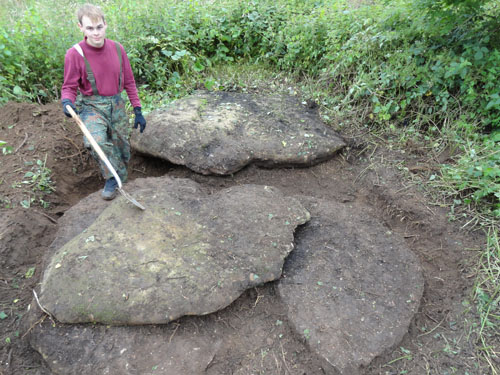
Digger Adam Belk exposing the stones
In August, 2012
- KBS News advised the village that the War Memorial was 'getting closer'.
- The Memorial Crescent design of five stones with inset plaques was approved
- A Street Collection Permit was obtained from VOWH Letters of explanation were hand delivered to residents around the site of the proposed Memorial Crescent. Only one resident objected (and they are friendly towards the project, now)
- On 31 August, Appeal letters were despatched to 38 companies and individuals
In September, 2012
- KBS News and posters in shops and pubs launched our Appeal for funding for the KBS War Memorial Crescent.
- on 11 September, we applied for a licence to run a War Memorial raffle
- on 23 September, guided by OCC Councillor Melinda Tilley we successfully applied for a donation under the Governments 'Big Society' programme
- we negotiated with Judy Loomes over the exact wording of the Provenance Plaque, which is in the east side of Stone Three and tells the story of the stones
In October, 2012 -
- KBS News announced our War Memorial raffle and we started selling tickets - giving ourselves 34 days until the final fund raising evening announced for 3 November. John Weston became a familiar sight at the front door of many homes. Sometimes, people 'just put money in the bucket' - but John outsold everyone.
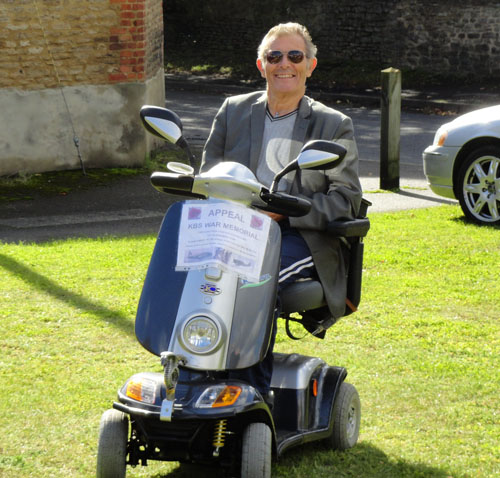
John Weston - out collecting
- Saturday 6th was an epic day in which all became real. Cliff Belcher, sons and their colleagues moved the stones. Easily said, hugely demanding of experience and skill in the use of large machinery and the ancient art of lifting and moving monolithic blocks of stone, with slings. Cliff and Neal Belcher were at the Southmoor Henge site really early on 6 October with their N. A. P Transport, Ltd 65 ton telescopic crane, trailer and super-strength nylon slings - with which lifting and loading the stones was soon accomplished.
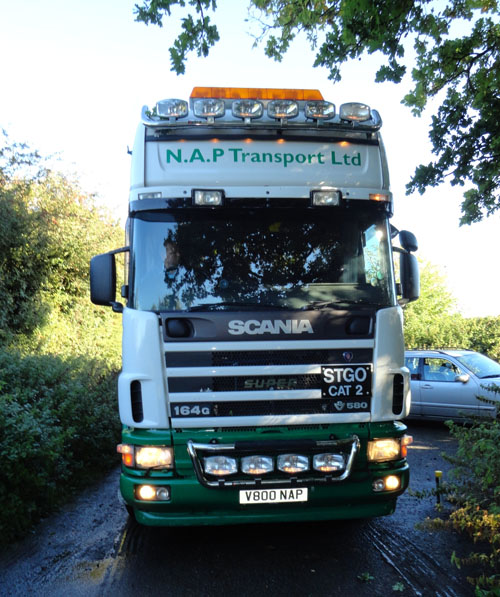
N.A.P.'s 65 ton telescopic crane rig arriving at the Southmoor Henge site
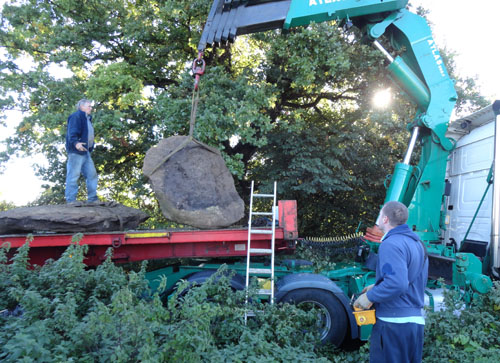
Cliff and Neal Belcher lift and load the Southmoor Henge stones
- The next act, which took longer than loading the stones, was to find the Time Capsule, buried there by farmer Richard Cox, in 1992. Using spades, we dug under where the stones had been, to no avail. A call to Judy Loomes, Richard's daughter elicited the memory that the Capsule was buried 'somewhere to the side of a stone and about three feet deep'. At this news, spades were parked and the heavy brigade called-in, in the shape of Tom Belcher and his excavator. Judy Loomes also joined us - and, as if by magic, Tom started to dig a trench across the site - and found the Capsule within moments! The capsule was soon up and the outer coverings removed to reveal a hand-written note from Richard Cox - 'not to be opened until 2092'.
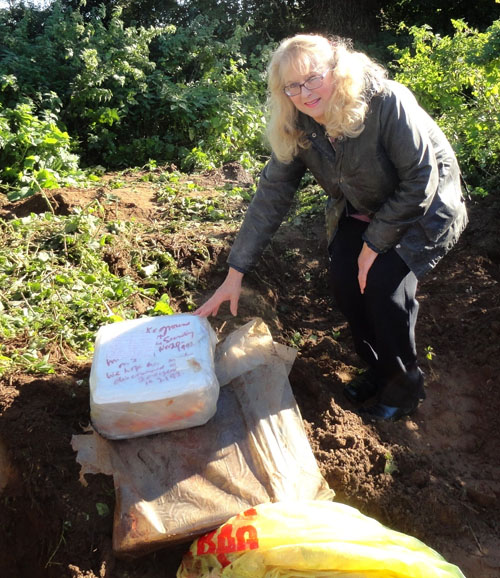
Judy Loomes, née Cox, and her father's Time Capsule memorial
-
We handed the Capsule to Judy and asked that she add the day's newspapers, latest KBS News and, if she wished, a posterity note from herself - then repackage all and return it to us at the Memorial Crescent site, that evening. This she did and in the gathering dusk, we reburied the capsule alongside the stones (exact site known to Judy). Before we left the Southmoor Henge site, we set the sixth stone vertically in the old boundary-marker stone position, and levelled the area.
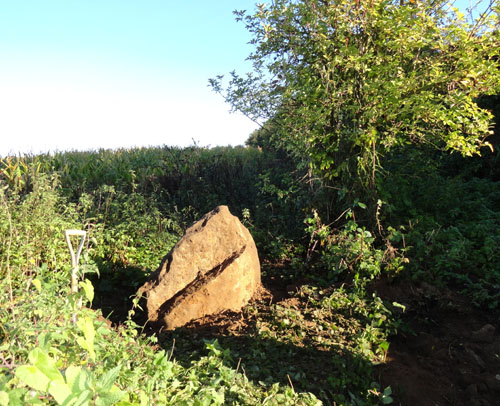
The Boundary Marker Stone left in position at Southmoor Henge
-
Action now switched to the Memorial Crescent position at the junction of Oxford Road and the A415. We had already marked-out on the grass what we understood to be the position of the various underground services - and where we wished to have the five stones. The issue we had to deal with was that the stone positions and supposed service routings were perilously close to each other - and the Highways services maps all carried disclaimers as to accuracy in large typeface! So, we took the decision to dig all five holes first, as, if we were to hit services, then the whole crescent would have to be moved. In the event, we didn't hit any services, but, by the third hole, we did hit the route of the old, very well metalled A420 road. This necessitated the use of a pneumatic drill. The first two A420-free holes took less than 5 minutes each to dig. The last three holes took nigh-on an hour each.
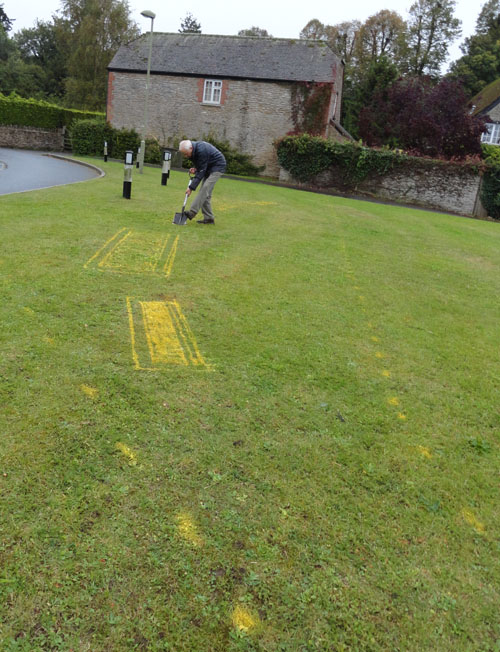
Rob Belk marks out the Stone positions.
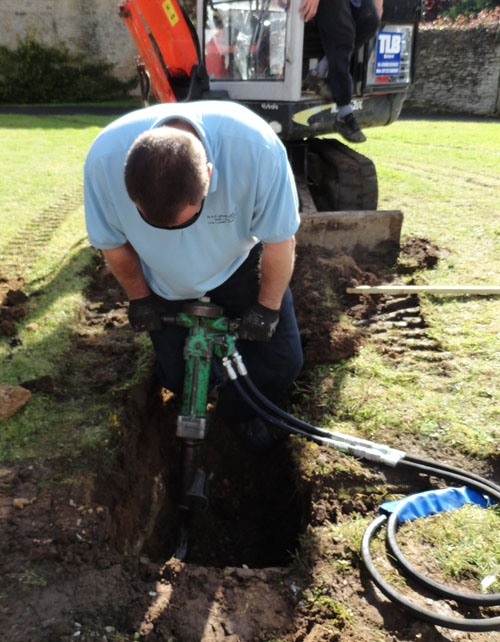
Neal Belcher deals with the old A420.
- Hole depth varied as we wanted the three middle stones at 1.20 m height above ground and the two flanking stones at 1.0 m height - so all excess length had to be buried. And of course, the deepest holes were the last three stones ('Tall-Boy' Stone Four necessitated a hole 1.65 m deep).
-
It was an afternoon of measuring and much tolerance on behalf of Cliff Belcher and his team towards the man with the tape measure - digging, lifting, lowering, adjusting left, right, up, down - until, towards dusk, the Memorial Crescent was pride of the green. A huge achievement. The reality of the Memorial Crescent was in place for all to see and believe in. But of course, the Stones were 'empty' - and the Appeal very much in progress, for, in order to achieve our target of being ready for Remembrance Day, we had to place the order for the Welsh Slate Remembrance Plaques by 9 October. This we did, with only 25% of the Appeal Target in the bank - and used it all as the down-payment. Given our perilous Appeal position - on 10 October, another 15 Appeal letters were despatched to companies and individuals and John Weston, Andre King and Anita McClewan gave considerable time to house-to-house sales of raffle tickets.
There then began a series of five 'plaque template trials' - to get right the size and positioning of the formal plaques on the highly individualistic stones.
Planning also then began in earnest for the last fund raising act - the 'Names Set in Stones and Music' evening on 3 November. We knew that the date clashed with Bonfire Night - but also that come 5 November, we would need to start to fit the Remembrance Plaques - and the Appeal appeal would be virtually over! 'Names' promotion posters were put in place, Ruth Hastings volunteered her 'Harmony Inspires' A Cappella chorus, Alan Bolder volunteered his Abbey Sax saxophonists and both worked on scores that would recall the music 'Names in Stone' would have known as they set-out on their last missions. In addition, of course, the 'Names' PowerPoint presentation had to be created and Ron Green needed to recruit volunteers to help with the buffet and bar.
It all came together. On 3 November, Abbey Sax played-in some 55 people. The presentation was well received and Harmony Inspires and Stan Webb were wonderful singers. And that very night, David Warr stepped forward and said that he would fund the Canadian Flag (two other donors have since said that they will pay for the American and Union flags).
Week commencing 5 November was 'Plaques Week'. Three masons from Abingdon Stone Ltd came and 'inset' the five stones ready for the plaques.
The Corallian limestone was harder than granite, they said - wearing out their diamond-tipped cutters at an alarming rate and taking days longer than anticipated. The BBC turned-up on the last day, to film the plaques being put in place and record an interview with Murray Maclean, the nephew of Wellington Bomber pilot, Donald Maclean, who gave his life for his crew, on 1 October, 1940 - and who, in a very real sense, was 'coming home', the Memorial Crescent being on land once owned by his family.
By 8 November, the KBS Memorial Crescent was complete - and ready for the Remembrance Day Service, on Sunday, 11 November, 2012.
Anatomy of giving
The overall Appeal ran for 64 days (1 September to 3 November, 2012). We started with individual letters to key potential donors and Appeal Buckets in local shops and pubs. The raffle began on 1 October and ran for 34 days and the Appeal culminated in the 'Names' evening on 3 November. Collection buckets in shops and pubs were emptied weekly.
Cliff Belcher and his family and colleagues gave freely of their time, expertise and equipment to move the stones and the Appeal would not have been successful without the unstinting support of other members of the KBS War Memorial Working Group, especially Ron Green, Brian Forster, John Weston and Melinda Tilley. The mission would not have succeeded at all without the wholesale support of spouses of the above, in particular, Clare Belk.
The funding breakdown for the remembrance plaques was as follows:-
- 35% from Promotions (Table-top sale, Buckets in Shops & Pubs, Raffle & 'Names' evening)
- 65% from 37 Donations (12 of them in response to the 53 letters)
- No single donation was more than 10% of the Appeal target.
In addition, as noted above, three individuals offered to fund the three flags - and Mr Robert Mattock offered to fund and manage rose borders to the Memorial Crescent green.
The Kingston Bagpuize with Southmoor War Memorial Crescent is unique and striking:-
- The Stones are 150 million years old Corallian Limestone 'Doggers'. Not hewn from a quarry - but like us - free spirits, individual, stronger together
- The Crescent design is a simple arc-amphitheatre in which to reflect upon the whole or to study, remember, honour the individual
- The Plaques are Welsh Slate. A contrasting grey. Dense. Sharply lettered. Formal.
The KBS Memorial Crescent is truly a village war memorial that forever honours and thanks:-
- All local men who have been killed for our freedoms since 14 October, 1066 (Hastings) with the general dedication "by these stones, we will remember them".
- Ten local men mostly killed far away, in WWI and WWII.
- Fourteen Allied Air Crew, killed on top of and around our village in WWII. Men from far away, killed right here. Reunited as crews, right here. They include 8 British RAF men, 3 American USAAF men and 3 Canadian RCAF men.
- RAF Horsa and Oxford Training Crew - and US 9th Army Air Force, Engineering Battalians and other US Army units based in our village and at Airfield Base 403, up until their deployment to Normandy in 1944.
- Those who have continued to die for our freedoms in conflicts since WWII.
All names are listed in the order in which they died (not alphabetically), so that the plaques better tell their story against the broad canvas of war.
A 6th plaque on the east side of Stone Three tells 'The Story of The Stones' and includes a geological explanation for the school children amongst us.
Several people included touching notes with their War Memorial Appeal Fund donations. Perhaps the best was from Owen Developments. It said -
"we have heard many stories over the years about what went on during the war. . We should never be allowed to forget the tremendous sacrifice made and for the younger generation to know THIS WAS NOT A STORY - IT WAS REAL AND THE PEOPLE WERE REAL AND THEY HAD NAMES AND FAMILIES".

Rob Belk
May 2013
|